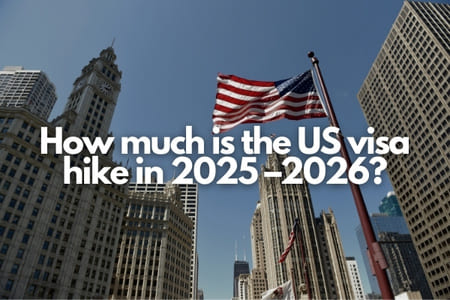How Much is the US Visa Hike in 2025 - 2026?
As of 2026, the US visa fees have increased by 10% to 40%, depending on the category. Work visas like H-1B and L-1 saw the steepest rise, while tourist (B-1/B-2) and student (F-1) visas had more moderate increases.
How much is the USA visa fee now?
Here’s a quick overview of the standard non-immigrant visa fees in 2026:
|
Visa Type |
Fee in USD |
|
B-1/B-2 Tourist |
$185 |
|
F-1 Student |
$180 |
|
H-1B Work Visa |
$780 + additional fees |
|
L-1 Transfer |
$850 |
|
K-1 Fiancé Visa |
$300 |
Note: Fees vary by visa class and may include service or processing charges.
Is the visa fee $185?
Yes, the standard U.S. tourist visa (B-1/B-2) now costs $185 as of 2026. This fee is for the application only and does not guarantee visa approval.
What is the visa fee for India from the USA?
If you are applying for an Indian visa from the United States, the fee depends on your visa type and duration:
- Tourist Visa (10 years multiple-entry): ~$150 to $180
- Business Visa: ~$200+
- e-Visa (Tourist): ~$25 to $100 depending on validity
Fees may vary by processing time and consular jurisdiction.
How much is the US visa fee in 2025?
In 2025, most non-immigrant US visa fees were as follows:
- B-1/B-2 (Tourist/Business): $160
- F-1 (Student): $160
- H-1B (Work Visa): $460 + extra fees
- L-1 (Transfer): $500+
These have now increased in 2026. Apply early to lock in older rates when possible.
How many visas will the USA give in 2025?
While the exact number may vary, the U.S. government projected issuing over 12 million non-immigrant visas in 2025. These include tourist, student, business, and work-related visas. Immigrant (green card) issuance is separate and capped annually.
Is there a 10-year USA visa?
Yes. The 10-year multiple-entry visa is available for citizens of countries like India, China, and Brazil under the B-1/B-2 category. It allows multiple short visits, each typically up to 6 months, within 10 years.
How much does a 10-year US visa cost?
For Indian citizens, a 10-year US tourist visa (B-1/B-2) costs $185 (as of 2026). This is the application fee only; it is non-refundable even if the visa is denied.
Are Indians getting a US visa?
Yes, U.S. consulates in India are actively processing visas for all categories. Wait times have improved significantly in 2025 and 2026, especially for students and business travelers. Emergency appointments and interview waivers are also available for eligible applicants.
What is the new rule for US visas in 2026?
In 2026, major changes include:
- Increased visa application fees
- Faster processing for high-priority visas
- Expansion of interview waiver programs
- Introduction of the Visa Integrity Fee for certain employers
Always check with your nearest U.S. consulate for the latest updates.
What is the Visa Integrity Fee?
The Visa Integrity Fee is a new charge aimed at employers who rely heavily on H-1B and L-1 workers. Companies with over 50 employees where more than 50% are on temporary work visas may have to pay additional fees to discourage visa overuse.
What is the total cost of a US visa?
Here’s what a typical US visa might cost in total:
|
Visa Type |
Base Fee |
Additional Costs |
Total Approx. |
|
B-1/B-2 |
$185 |
$0–$20 (delivery) |
$185–$200 |
|
F-1 |
$180 |
$350 (SEVIS) |
$530+ |
|
H-1B |
$780 |
$1,500–$3,000 (legal + filing) |
$2,000–$4,000 |
|
L-1 |
$850 |
Employer fees |
$1,500+ |
How much is the US visa fee payment?
The US visa fee payment must be made in local currency at designated banks or online platforms. In India, payment can be made through NEFT, mobile wallets, or cash at Axis/ICICI branches.
How much are visa fees to the USA?
Visa fees to the U.S. vary based on type and country. On average:
- Tourist Visa (B-1/B-2): $185
- Student Visa (F-1): $180 + SEVIS
- Work Visa (H-1B): $780 (plus employer costs)
Some visas may also include fraud prevention or security fees.
What is the visa fee for India from the USA?
For U.S. citizens visiting India:
- Tourist e-Visa (30 days): $25–$40
- 1-Year or 5-Year Visa: ~$100–$180
- Business Visa: $200+
Check with the Indian Embassy or VFS Global for updated rates.
What is the cost of a US tourist visa from India?
The US tourist visa (B-1/B-2) fee for Indian citizens is currently ₹15,500 to ₹16,000 (approx. $185 USD). This includes application processing and appointment scheduling.
How to get a 10-year US visa?
To apply for a 10-year US visa from India, follow these steps:
- Complete Form DS-160 online
- Pay the $185 fee
- Book a visa interview appointment
- Prepare required documents (passport, photos, bank statements, travel itinerary)
- Attend the interview at the US consulate
If approved, the 10-year multiple-entry visa is stamped in your passport.
What is the cost of a US tourist visa from India?
The US tourist visa (B-1/B-2) fee for Indian citizens is currently ₹15,500 to ₹16,000 (approx. $185 USD). This includes application processing and appointment scheduling.
What is the fee for a US tourist visa?
As of 2026, the US tourist visa (B-1/B-2) fee is $185 worldwide. Some countries may include additional surcharges or service fees.
How Much is the US Visa Hike in 2025 - 2026?
A Big update for those who are planning and gonna plan ahead to visit the US. The year 2026 began with an unexpected update for thousands of people around the globe preparing to enter the United States: a sudden hike in US visa application fees. From students and tech workers to tourists and entrepreneurs, the news created waves of concern. But what caused this sharp increase? Is it temporary or part of a longer trend? And more importantly, how does it affect you?
As of early 2026, the US Department of State announced updated non-immigrant visa fees that apply to various categories, such as:
- B-1/B-2 (Tourism & Business Visitors)
- H-1B (Skilled Workers)
- F-1 (Students)
- L-1 (Intra-Company Transfers)
- O and P categories (Athletes, Artists, etc.)
The changes range from modest to steep depending on the category. While student visas saw a marginal rise, work-related visas like H-1B and L-1 saw significant increases.
The recent updated visa fee structure affects multiple groups, including:
Group Impact
International Students (F-1, M-1)Slight increase; adds to overall education cost
Skilled Workers (H-1B) : Noticeable rise in both application and fraud prevention fees
Company Sponsors (L-1, O-1) : Higher upfront costs for each sponsored employee
Tourists & Visitors (B-1/B-2) Increased cost might deter short visits
Family-Based Immigrants (K Visa). Some categories saw modest hikes
Several underlying factors contributed to this decision:
Administrative Cost Recovery
The US visa process is mostly self-funded, meaning application fees cover the cost of reviewing, processing, and adjudicating visas. With rising inflation, staff costs, and technology expenses, the State Department is updating fees to match real processing costs.
Backlog Management Post-COVID
The pandemic caused severe backlogs in US embassies and consulates. This fee increase helps finance efforts to reduce the backlog, hire more staff, and speed up processing times.
Security Enhancements
Ongoing geopolitical tensions and data privacy concerns have pushed the US to invest more in visa security and background check systems—increased fees help fund these technologies.
Policy Realignment
There’s a strategic policy shift to prioritize long-term, merit-based immigration while controlling high-volume short-term entries. Adjusting fees is part of this realignment.
Here’s a simplified comparison of the most relevant visa categories before and after the hike:
Visa Type 2025 Fee (USD) 2026 Fee (USD) % Increase
B-1/B-2 (Tourist/Business) $160 $185 15.6%
F-1 (Student) $160 $180 12.5%
H-1B (Skilled Worker) $460 + $500 (ACWIA) $780 + $600 ~30-40%
L-1 (Intra-company) $500 $850 70%
K (Fiancé) $265 $300 13%
Note: These numbers are estimates based on current projections and may vary slightly by consulate.
While some applicants may shrug off the additional $25–$50, others—particularly students and mid-sized businesses sponsoring workers—are feeling the pinch.
For Students:
- Even a small fee hike adds up when combined with SEVIS fees, tuition, insurance, and living costs.
- It may discourage lower-income applicants or push them to consider more affordable study destinations.
For Tech Talent:
- Startups and mid-sized companies hiring foreign talent face larger upfront costs.
- Some may choose to sponsor fewer workers or delay recruitment.
For Families and Visitors:
- Occasional travelers may reconsider travel plans due to increased cost, especially for family-based group travel.
The fee hike is unavoidable, but there are ways to minimize the impact and plan ahead definately to save up
Apply Early
If you’re planning to travel or apply for a visa in late 2026, try to submit your application early. Lock in the current fee before any further hikes.
Budget Accordingly
Factor in visa fees into your overall migration or education budget. Use official government sites to stay updated on charges.
Seek Fee Waivers (If Eligible)
Certain categories, like students from low-income countries or humanitarian applicants, may qualify for partial waivers or embassy assistance.
Work with Legal Experts
For work visas, consult immigration attorneys to optimize filings and avoid rejections, which could cost even more in re-application fees.
Explore Alternative Routes
If you’re a skilled worker, countries like Canada, Australia, or Germany may offer faster or more cost-effective migration options.
The 2026 US visa fee hike, while surprising, is a part of a broader shift in US immigration policy. It reflects the growing need for sustainable visa processing, enhanced security, and policy restructuring.
Whether you’re a student dreaming of studying in California, a tech worker eyeing Silicon Valley, or a tourist eager to explore Times Square, the new fees shouldn’t deter you, but they do call for smarter planning.
Keep your documents ready, stay updated through official channels, and factor these changes into your long-term plans. The American dream is still within reach—it might just cost a little more now.



Comment (0)